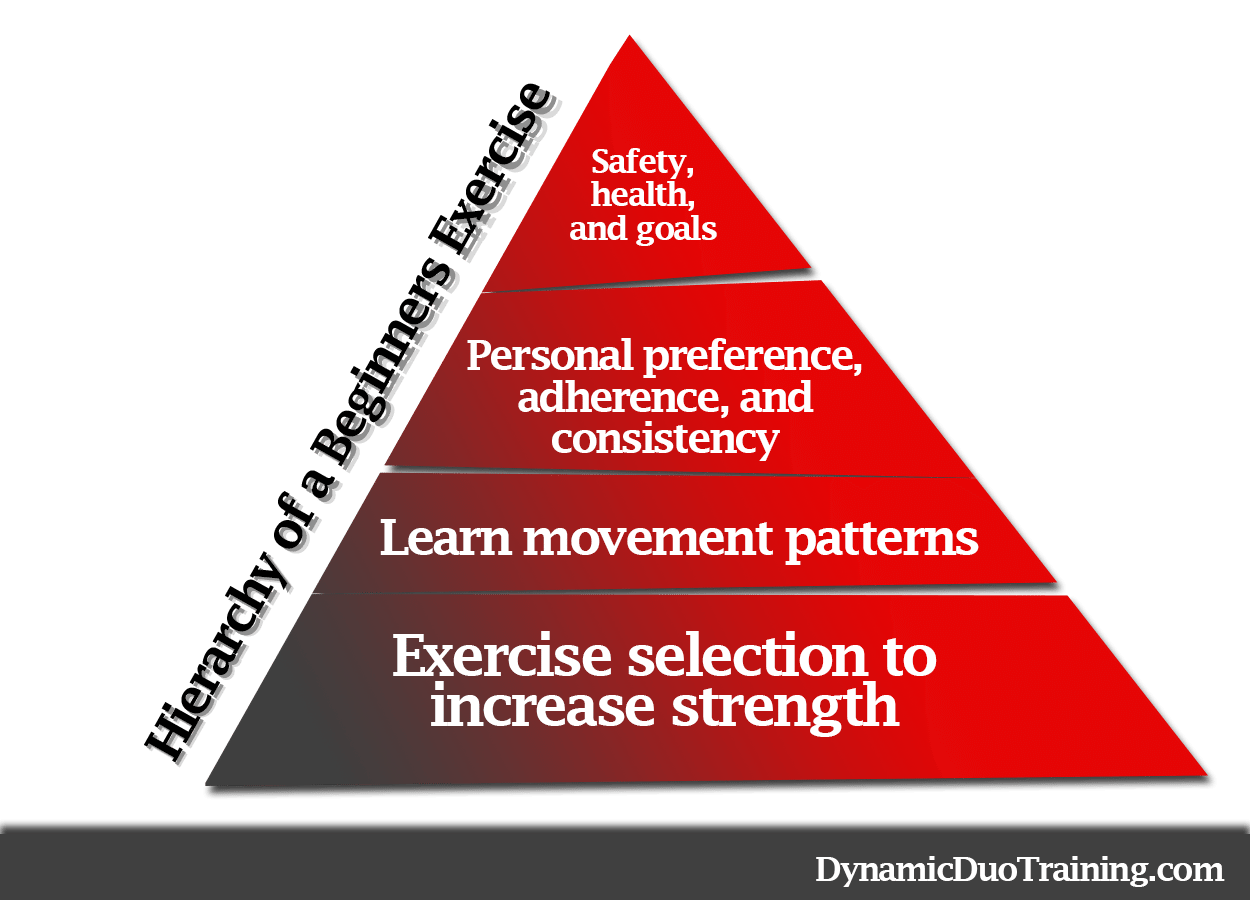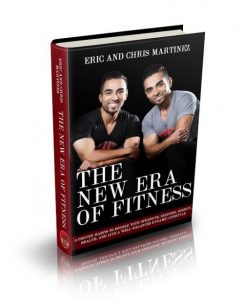After reading Part 1 on Building Good Habits and Part II on the Hierarchy of Beginners Nutrition, we hope this is really paving a solid foundation for what it takes the beginner to have success within their fitness journeys.
Now that we move into part 3, we want to discuss the hierarchy of beginner’s exercise and what’s most important.
Before we start hitting the weights, we really like what Eric Helms refers to as REF within an exercise program (1).
R- Realistic: Program needs to be realistic for your schedule and goals
E- Enjoyable: Program needs to be enjoyable to work harder at
F- Flexible: Program needs to be flexible in case life factors occur
Another point that really resonated with us was by Mark Rippetoe (2):
“Programming for the novice is the most important task a coach will encounter and the most important task an athlete can undertake. Done correctly, it sets the stage for a lifetime of proper training habits, long-term progress, and athletic achievement far above what would be possible without it.”
Incorporating these key elements are absolutely needed in order to increase adherence and consistency, which in turn, is the most important component at the end of the day for any exercise program and getting results.
Are you ready to learn the hierarchy of beginner’s exercise?
Bring out the dumbbells, save the pyramid image below, take notes, and let’s dig in.

Safety, Health, and Goals
We know some of you that are reading this are expecting a reference for putting safety, health, and goals as the most important factor for a beginners exercise program…but guess what? You aren’t getting one because anecdotal evidence tells us if you don’t put safety and health first, then how will you progress and get results when you’re on the sideline injured? And how will you make long-term gains in strength and muscle mass without any kind of goals in place?
This really comes down to common sense, not some controlled scientific experiment 😉
So make sure to use safety when training, proper form is always advocated. Make sure to stay healthy so you can progress. And make sure to set attainable goals to increase motivation and thus get gains in strength and muscle mass.
PAC
Were you thinking Pac Man like the classic video game? It’s okay if you were that game was pretty awesome!
On a serious note, PAC stands for:
P- Personal Preference
A- Adherence
C- Consistency
PAC is very similar to what we talked about with REF.
PAC is needed for any type of trainee…beginners, intermediate, advanced, or elite level. Without PAC being incorporated into your exercise program, don’t expect to get any real results and here’s why:
Your exercise program needs to include some personal preference. If we say “Hey Kim Kardashian, go do some squats and deadlifts and then call it a day.”
What if Kim doesn’t like squats or deadlifts?
What if she can’t physically or biomechanically perform squats or deadlifts?
We can’t force her to do it and chances are if we did force her, there would be no enjoyment, it would lead to her not working as hard, adherence and consistency would be low, and thus not getting much results.
So you should always include some sort of personal preference into your exercise program and that means doing a program that’s going to excite you, one that you’re going to enjoy doing, and eventually make you work harder, so that adherence and consistency increases and thus get more results.
Learn Movement Patterns
Next up for the beginner, they need to learn basic movement patterns. We know that theory, applied science and actual application are all needed in fitness. Studies are the theory, books based on studies are the applied science, and then actually training clients and writing programs is the application.
Through all three of these, we have found that there are four basic movement patterns a beginner needs to learn in order to teach their brains to become more efficient at and thus continue to progress over time whether that’s adding more volume, adding more frequency, increasing intensity, doing more advanced exercises, or a combination of all (3).
The four basic movement patterns you want to learn are:
Push Exercise-
- Overhead BB/DB Press
- DB/BB Bench Press
- DB/BB Floor Press

Pull Exercise-
- Bent over BB/DB Row
- Chin Up, Pull Up or Pulldown
- Seated Cable Row
- Standing T Bar Row

Squat/Lunge Exercise:
- Squat
- Front Squat
- Box Squat
- Leg Press
- Lunges

Hip Hinge Exercise:
- Deadlift
- Glute Bridge/Hip Thrusts
- RDL’s

If you master these four basic movement patterns, 99.9% of the time you will be able to progress more efficiently and set yourself up for proper training habits, long-term progress, and athletic achievement.
Exercise Selection to Increase Strength
Last but certainly not least on the pyramid is exercise selection to increase strength. The importance of exercise selection varies depending on perspective, but in the context of a beginner it’s important to take into consideration to emphasize choosing proper exercises to increase strength.
In Eric Helms “Muscle and Strength Pyramid Training” he states (3):
“For hypertrophy, a wide variety of exercises can be used to stimulate growth. That being said, based on the biomechanics of the individual, some exercises may be more effective than others. This is also relevant consideration for a strength athlete. For example, even though a powerlifter may have to squat, in some cases the squat may not produce balanced development if that specific powerlifter is not well built to squat. Therefore they might be better suited to doing more assistance work for leg development rather than more squats compared to someone who had limb and torso lengths well suited to squatting.”
Another important aspect we need to consider is exercise selection should be centered on the goal of your training and that means whether you’re training purely for muscle mass like a bodybuilder or training for strength like a powerlifter.
We recommend a beginner starts with multi joint or compound movements like the ones we suggested above under movement patterns and then focus on secondary or isolation exercises.
It’s important for the beginner to properly order their exercises in a manner where they can:
- Put enough effort into each rep, and perform that rep correctly
- Putting enough effort into each set
- Selecting the right exercises and ordering them effectively within their training session
- Making sure the session accomplished its purpose
- Making sure the training week itself is laid out well to allow them to train hard within each session and recover effectively between sessions so they can progress
Our new physical paperback book “The New Era of Fitness” is finally out! We are pretty much giving it away “FREE” and giving away a “FEW BONUSES” along with it. Get it HERE
References:
- Eric Helms. The muscle and strength pyramid training. 2016
- Mark Rippetoe and Andy Baker. Practical programming for strength training. 2013
- Baechle and Earle. Essentials of Strength Training and Conditioning. 2008


